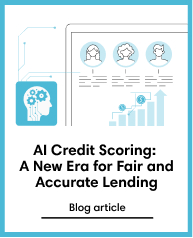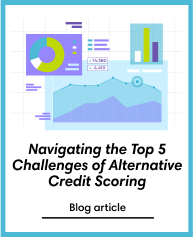Credit Scoring
Nov 5, 2025
The Future of Credit Scoring: Beyond Traditional Models
Subscribe to our newsletter
Credit scoring has long been a central component of lending. For decades, banks and financial institutions relied on bureau data and fixed scorecards to determine credit eligibility. However, as customer expectations evolve and the digital-first world accelerates, these old lending models are no longer enough.
Today, consumers expect quick, fair, and personalised credit decisions, but traditional systems—dependent on static data and slow approvals—often fall short. Lenders must adjust to new challenges: balancing speed, fairness, and inclusivity for a diverse customer base.
ML for credit scoring is the key solution to these challenges. Lenders can create faster, more accurate, and inclusive credit models by analysing privacy-consented device and behavioural data powered by artificial intelligence (AI) and machine learning (ML) models.. These models provide better predictions, fairer decisions, and the ability to adapt to changing customer behaviour and market conditions. In short, ML for credit scoring is the future and the backbone of modern lending.
Why Traditional Credit Scoring Models Are No Longer Enough
Traditional credit scoring models, such as the Fair Isaac Corporation (FICO) score, were developed using credit-report data and were designed for an era when decisions were solely based on past repayment history and outstanding debts.
Today, these traditional systems are increasingly inadequate. They are slow to adapt and fail to capture real-time data, such as consumer spending, mobile usage, and other non-traditional signals.
In a digital-first world, consumers demand faster, personalised credit decisions. Traditional models, which rely on static data and slow bureau checks, cannot keep pace with the evolving needs of the market. ML for credit scoring addresses this gap by processing a wide range of real-time data, including behavioural and device metadata. ML-powered models evaluate hundreds of data points in seconds, delivering faster, more accurate, and fairer decisions.
Limitations of FICO and Traditional Models
FICO scores and other traditional credit scoring systems rely heavily on historical financial data. They evaluate an applicant’s creditworthiness based on past loans, credit card usage, and repayment behaviour. While this approach works for individuals with well-established credit histories, it fails to provide an accurate picture for those with limited credit activity, such as younger consumers, the underbanked, or gig economy workers.
Moreover, traditional models are inflexible and slow to adapt. They cannot adjust in real-time to changes in an individual’s financial situation. For example, if someone experiences a temporary dip in credit card usage but continues to make payments through other platforms, traditional models fail to capture that behaviour.
In contrast, AI/ML models can integrate real-time data, such as spending behaviour, device usage, and geolocation, allowing for more dynamic and accurate credit scoring.
Growing Demand for Faster and Fairer Decisions
In a world of instant transactions, consumers expect the same speed and convenience when applying for credit. Traditional credit systems, which can take days to process and often require manual reviews, can’t keep up. Consumers also demand transparency; they want to understand why they were approved or denied credit. Traditional models offer little insight, leaving applicants frustrated.
AI/ML-based systems meet these demands with speed, accuracy, and transparency. These models can evaluate hundreds of data points in seconds, enabling instant approval decisions. They offer fairer decisions by incorporating alternative data, such as behavioural insights, especially for applicants without traditional credit histories. This builds trust and reduces the risk of losing potential borrowers.
Rise In Underbanked And Thin-Credit File Applicants
Traditional credit scoring models often fail to assess individuals with limited or no formal credit history—referred to as "credit invisibles." These individuals are typically excluded from accessing loans or credit products, restricting their financial inclusion and opportunities.
- Southeast Asia: Singapore leads Southeast Asia in credit card penetration, with around 80% of merchants accepting cards and credit card payments representing 71% of transactions in 2023, which is expected to rise to 75% by 2028. Vietnam is rapidly expanding its credit card market, with 86% merchant acceptance in 2024 and card-based transactions growing from 27% in 2023 to an expected 31% by 2028. These trends reflect increasing consumer demand and emphasize the need for advanced credit scoring models that incorporate alternative financial data to better serve these growing, digitally active populations. (Source)
- Latin America: Globally, 79% of adults have a financial account at a bank or with a mobile money provider. In Latin America and the Caribbean, 37% of adults had a mobile money account in 2024, an increase from 22% in 2021. Formal savings through mobile money accounts reached 19% of adults, four times higher than in 2021. (Source)
Digital and electronic payments now make up 60% of consumer spending in Latin America in 2025, while cash use has dropped from 57% in 2022 to 37% in countries like Brazil, Mexico, Colombia, Argentina, Chile, Peru, and Costa Rica. This shows a clear shift away from cash toward digital payments, driven by faster options like instant transfers and mobile wallets. (Source)
- Sub-Saharan Africa: Sub-Saharan Africa has seen remarkable progress in financial inclusion, with 49% of adults owning a financial account, more than doubling since 2011. Account ownership varies widely, from 6% in South Sudan to 91% in Mauritius. Key economies like Kenya (79%), Senegal (56%), and South Africa (85%) show strong adoption. Mobile money plays a crucial role in this growth, driving double-digit account increases in several countries between 2017 and 2022. (Source)
These challenges underscore the need for alternative data credit scoring to provide more inclusive financial services. ML for credit scoring solves this by incorporating non-traditional data, such as mobile phone usage and utility payments, allowing lenders to assess a broader spectrum of applicants. AI-powered credit scoring systems can quickly process diverse data points, offering a faster, fairer, and more inclusive decision process for those previously excluded by traditional models.
How Artificial Intelligence and Machine Learning Have Transformed Credit Decisioning
The shortcomings of traditional credit scoring have created space for new approaches. AI is often discussed in this context, but in practice, it is ML credit scoring models that deliver measurable benefits for lenders today. By learning from data and adapting to new behaviours, ML has reshaped how credit risk decisioning is assessed, how quickly approvals are given, and how inclusivity is achieved in lending.
Introduction To Artificial Intelligence And Machine Learning For Credit Scoring
AI encompasses technologies that enable machines to perform tasks that typically require human judgment, such as natural language processing, computer vision, and robotics. For lenders today, the most impactful tool is ML.
ML models are trained on past data, including borrower histories, repayment outcomes, and privacy-consented behavioural and device data. These models identify patterns linked to repayment or default and apply them to score new applicants based on this combination of data..
The ML credit scoring process can be summarised in four steps:
- Data Collection: Gather bureau records, application data, and alternative signals.
- Model Training: Teach the system what good and bad risks look like using past outcomes.
- New Applicant Scoring: Generate a probability of repayment or default.
- Performance Monitoring: Track accuracy, detect drift, and retrain as behaviours evolve.
This cycle ensures the model stays relevant and adaptable. Unlike static scorecards, ML-powered credit scoring models adjust in near real time, transforming credit assessment from a fixed calculation into a dynamic, continuously improving system.
Benefits Of ML In Credit Scoring
ML offers three key advantages: speed, accuracy, and personalisation. It enhances credit scoring by enabling faster decisions, improved accuracy through analysis of thousands of data points, and tailored risk assessments. It broadens credit access by incorporating alternative behavioral data, making lending more inclusive and responsive to individual financial profiles than traditional models.
- Speed
Traditional systems can take hours or days to process credit applications. ML models, powered by APIs, provide instant scores in milliseconds. This enables automated credit decisioning at the point of application, creating seamless experiences, such as approving a credit line in a shopping app before the checkout process. Credolab’s platform exemplifies this by delivering real-time decisions and ensuring both speed and accuracy.
ML-powered credit scoring not only delivers fast results but also reduces operational bottlenecks and manual workload for lenders. By automating data collection and evaluation, it cuts costs and frees teams to focus on complex cases, improving overall efficiency without sacrificing decision quality. This automation also helps lenders scale their operations smoothly during peak demand periods, maintaining consistent decision quality and customer satisfaction.
- Accuracy
Traditional models rely on limited data. ML utilises thousands of data points, such as hesitation times, editing behaviour, and device configurations, enabling precise credit risk decisioning. This reduces both false approvals and declines, resulting in healthier portfolios. Credolab’s AI-powered credit scoring system allows lenders to analyse 11 million features in real time, improving decision accuracy and outcomes for customers and lenders.
ML models continuously learn from new data inputs, allowing lenders to rapidly adjust credit risk predictions as borrower behavior changes or economic conditions shift. This adaptability leads to more resilient portfolios that can better withstand market volatility and unforeseen financial challenges. They are designed to comply with regulatory standards, offering transparent, explainable decisions that meet legal and ethical requirements while safeguarding consumer privacy.
- Personalisation
Traditional scores often group applicants broadly, leading to unfair declines. ML-based models create granular risk profiles, tailoring credit offers to individual needs. For example, a young borrower with limited history but strong behavioural signals may receive a starter loan with an adjustable limit. Credolab’s approach personalises risk profiles based on deep behavioural insights, allowing lenders to offer tailored, responsible credit, especially to credit invisibles.
ML is transforming credit scoring by providing faster, fairer, and more inclusive lending decisions. Lenders benefit from higher approval rates, fewer losses, and broader market reach, making ML a core component of modern lending.
These advancements in speed, accuracy, and personalisation set the stage for broader adoption of ML-powered systems across various global markets, enabling lenders to meet the growing demand for fast and fair credit decisioning
Key Technologies Powering the Shift
To remain competitive in today’s lending environment, financial institutions need advanced models and a robust technological foundation. Application Programming Interfaces (APIs), Software Development Kits (SDKs), and cloud infrastructure are the key components enabling ML credit scoring models to process real-time data and adapt to market changes.
Credolab’s SDKs and APIs empower lenders to access privacy-consented device data and behavioural metadata, enhancing predictive analytics. By partnering with technology leaders, lenders can build seamless, scalable credit decisioning platforms that improve both speed and accuracy.
This strategic integration enables financial institutions to leverage new data sources, maintain a competitive edge, and drive credit scoring innovation.
Role Of APIs, SDKs And Cloud Infrastructure
APIs provide secure, real-time connections between systems, enabling lenders to instantly request and receive credit scores, ensuring a seamless customer experience.
SDKs are embedded into mobile apps and websites, capturing behavioural data and device metadata with explicit consent, without disrupting the user experience. This provides lenders with real-time, rich data for better decisioning.
Cloud infrastructure ties everything together, enabling scalability, resilience, and compliance across regions. A cloud-based credit decisioning environment enables lenders to process large volumes of applications quickly, retrain models efficiently, and maintain robust security controls.
Credolab strengthens this framework by offering:
- A cloud-based API-driven SDK that seamlessly integrates into existing systems and enhances risk assessment, fraud detection, and marketing optimisation.
- Over 11 million features are available for analysis, providing a broad range of predictive signals.
- SDK is triggered at the point of application, ensuring every applicant is scored
Together, these technologies form the backbone of a reliable credit scoring platform, enabling lenders to deploy automated credit decisioning systems that are fast, efficient, and transparent, while maintaining compliance and customer trust.
AI and Credit Risk Decisioning
Lenders today face the challenge of balancing growth with risk control. They aim to approve more reliable customers while reducing fraud and defaults. Traditional scorecards often struggle with this, as they tend to group applicants too broadly. ML credit scoring models provide lenders with sharper tools by identifying signals that traditional systems miss.
How ML Enhances Credit Risk Modelling
ML enhances credit decision-making in three key ways: it provides more nuanced signals, increases adaptability, and reduces errors.
- Deeper Signals
Traditional models focus mainly on repayment history. ML introduces new insights, such as hesitation during the application, frequent corrections, or unusual device usage. These signals, when analysed at scale, enhance credit risk decisioning by offering more precision.
- Adaptability
Borrower behaviour, market conditions, and product types change rapidly. For instance, payment patterns shifted during the COVID-19 pandemic. Traditional scorecards update slowly, but ML models can retrain regularly, ensuring they stay accurate in both stable and volatile conditions.
- Fewer Errors
False approvals increase defaults, while false declines limit growth. ML reduces both by improving prediction accuracy, enabling lenders to approve more reliable borrowers while protecting against unnecessary losses.
Predictive analytics from behavioural data using ML algorithms can uncover subtle differences between applicants who may seem identical on paper. Some data-driven behavioural insights include tracking user interactions like Finger Gestures, Keystroke Dynamics, Time to Complete, and UI Interactions to identify those who hesitate, constantly edit form fields, or switch devices.
Regulatory Considerations & Ethical Challenges
As lenders adopt modern credit scoring models, compliance and ethics are just as crucial as accuracy. Regulators, customers, and partners expect credit decisioning to be not only precise but also fair, transparent, and privacy-safe. Without these foundations, even the most advanced models risk losing customer trust and damaging a lender’s reputation.
AI/ML Bias And Fairness In Credit Decisioning
One way to mitigate algorithm bias is by ensuring data diversity, model explainability and using transparent and interpretable models. To address end-user privacy concerns, lenders should use privacy-consented, anonymised and non-personal data.
For example, behavioural insights from alternative data platforms like Credolab are designed to provide strong predictive insights that are non-Personally Identifiable Information (PII), creating a privacy-by-design solution.
What Is a Good AI/ML Credit Score?
When lenders ask, “What is a good AI/ML credit score?” they often seek a universal benchmark. In reality, no single number defines a good score. A good AI/ML credit score is one that accurately predicts repayment, adapts to changing conditions, and supports business goals. Unlike traditional bureau scores, which are static and slow to evolve, ML-based scores are flexible and designed for modern lending environments.
How AI/ML Scores Differ From Traditional Scores
Traditional bureau scores place a heavy emphasis on repayment history and outstanding debts. This works for borrowers with long credit histories but excludes those without formal records. Millions of people worldwide fall into this category, leaving them invisible to traditional credit models.
ML credit scoring models address this gap by incorporating thousands of additional features, such as behavioural data and device metadata. These signals are anonymised and permissioned, offering lenders a richer, real-time view of each applicant while maintaining privacy.
Adaptability is another key advantage. Traditional scores are updated infrequently, whereas ML-driven models can refresh in real-time. This makes them highly effective in fast-changing markets or with new credit products.
Another advantage is orthogonality. Studies show that alternative data signals, like behavioural data and device metadata, are highly orthogonal to bureau data, meaning they provide fresh insights rather than duplicating existing information. Combined with bureau data, they enable more accurate cut-offs, fairer decisions, and stronger predictive power.
In practice, a good ML-based score strikes a balance between predictive accuracy, fairness, explainability, and alignment with business goals. This is where the difference between traditional and modern credit scoring becomes clear. Modern models are more inclusive, more dynamic, and better suited to today’s digital economy.
Future Trends in Credit Scoring
Credit scoring is shifting from static, bureau-driven models to dynamic, data-rich systems. As technology advances and customer expectations rise, lenders must adapt to stay competitive. The next wave of innovation will focus on embedded decisioning, smarter use of alternative data, and the responsible integration of emerging tools like generative AI.
Embedded Credit Scoring In Fintech Ecosystems
Credit scoring is no longer limited to banks and traditional loan applications. It is increasingly embedded in fintech ecosystems, such as neobanks, marketplaces, and super-apps, enabling instant approvals for loans, credit lines, or "buy now, pay later" services.
This shift is powered by automated credit decisioning, providing real-time approvals at the point of interaction. Customers benefit from seamless experiences, while lenders gain access to richer, real-time data. For lenders in regions with limited bureau coverage, integrating automated credit decisioning into fintech platforms provides a way to efficiently and responsibly serve new segments.
Uses of Alternative Data
Not all alternative data is equally valuable. To achieve strong results, lenders must focus on data with clear predictive power.
Privacy-consented behavioural data and device metadata offer the best insights, providing 100% coverage at the point of application. These signals complement traditional bureau data, adding fresh information for more accurate credit decisions.
Additional data sources, such as utility payments, telecommunications records, and subscription services, enhance this model by providing stability and reliability. When combined, these diverse data points create a more comprehensive view of applicants, helping lenders serve credit invisibles and expand access to credit.
Generative AI’s Potential In Enhancing Credit Models
Generative AI is attracting attention across industries, with potential applications in synthetic data generation, model stress testing, and fraud detection. It can simulate rare but critical events, like economic shocks or shifts in consumer behaviour, helping lenders assess how models might perform under stress.
However, generative AI should be seen as a supporting tool, not a replacement for ML credit scoring models. While it strengthens model robustness and governance, it is not yet reliable enough for live credit decisioning. For now, ML-powered systems remain the backbone of credit scoring innovation, with generative AI playing a role in enhancing resilience and model validation.
Conclusion
ML-powered credit scoring is essential for achieving faster approvals, stronger predictions, and more personalised outcomes. These models expand access to credit for individuals with credit invisibility without increasing risk.
Machine learning helps lenders make smarter choices by looking at lots of different information quickly. It finds patterns that people might miss. This means more people can get credit, and lenders can keep their risks low. It also helps create fairer and clearer credit decisions for everyone.
The future of credit scoring is about speed, fairness, and inclusivity. Institutions that adopt credit scoring innovation today will set the standard for tomorrow. With the right data and technology, ML models are already proving that better lending decisions are possible.
Transform your credit decisioning process today—leverage Credolab’s AI-powered solutions to gain a competitive edge, reduce risk, and expand on inclusive financial products. Contact us now to learn how we can help you deliver smarter, faster, and fairer credit decisions.
FAQs About AI/ML-Based Credit Scoring
What is AI/ML credit scoring, and how does it work?
AI refers to a broad set of technologies, but ML credit scoring models are the most widely used in modern lending. These models are trained on historical data, including repayment outcomes, bureau records, and privacy-consented behavioural data. The models identify patterns and predict the likelihood of repayment or default in real time. This allows lenders to make dynamic, data-driven decisions.
How is AI/ML-based credit decisioning safe and legal?
The foundation of safe and legal AI/ML decisioning is consent, privacy, and compliance. All signals used in a credit decisioning model are anonymised, depersonalised, and permissioned. Personal identifiers are not collected; only non-intrusive yet predictive metadata is collected. These systems comply with international frameworks, including GDPR, CCPA, LGPD, POPIA, and ISO 27001:2013.
Can AI/ML credit scoring reduce loan approval times?
Yes. Traditional credit scorecards and manual checks can take days, while ML for credit scoring delivers results in milliseconds. By utilising automated credit decisioning systems, lenders can instantly approve or decline applications, enhancing the customer experience, reducing abandonment rates, and improving operational efficiency.





